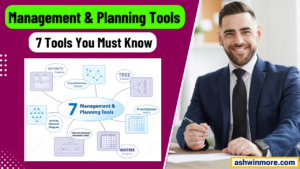How do some organizations achieve exceptional efficiency and continuous improvement in their operations? The answer is a powerful way of exploring the actual workplace where real work is happening and that way is called Gemba Walk.
Gemba Walk places you at the frontline of your organization’s daily operations and fosters a deep understanding of processes, identifying inefficiencies and empowering your team to drive meaningful change in the organization.
In this article, I am going to discuss the powerful Lean tool Gemba Walk in detail along with its benefits and most importantly I will discuss how to perform this workplace walk using 8 steps and achieve great results.
Are you ready to master this powerful tool that can propel your organization toward better efficiency and operational excellence? Let’s get started…
What is Gemba-Walk?
Just imagine you are the manager of a manufacturing plant. You saw a spreadsheet and reports related to one of the processes at your plant and those reports tell you there is a bottleneck in the process.
But you can’t solve that bottleneck issue just by analyzing the reports, you need to visit the actual workplace and observe the process to solve this issue that’s what Gemba Walk does.
See data on spreadsheets might tell you there is a bottleneck in the process but the workplace walk takes you right to the heart of the process to understand things in a better way.
You observe the machines, talk to the operators, and make real-time data-driven decision-making. Without the workplace walk your problem solving and decision making will be based on incomplete information.
That’s why this is considered one of the important initiatives an organization takes. The term Gemba comes from the Japanese language which means the actual place or the real place. It basically refers to a location where value is created in any operational setting.
It is the purposeful walk in which you visit the actual workplace area, engage with frontline employees, observe the process, and gain insights that you simply can’t grasp from behind the desk or just seeing reports.
The best thing about workplace walk is it promotes the deep connection between leaders and the actual work environment and this ultimately helps in effective problem-solving and strategic decision-making.
This tool or approach was developed by Toyota in mid 20th century, and it was an important part of the Toyota Production System. Taichi Ohno the father of TPS emphasized the importance of going to the Gemba to identify and eliminate waste.
He believed that understanding the real challenges and opportunities at the actual workplace could help make teams informed decisions and drive continuous improvement in the organization.
Over the period of time, this approach started with manufacturing companies but its use spread across the service, pharma, and healthcare industries. It has become an important part of the Lean and Six Sigma projects toolkit.

As a continuous improvement enthusiast why you should care about the Workpalce walk? becasue it’s a powerful tool to improve workplace efficiency, build engagement with employees and reduce process-related problems.
For continuous improvement data-driven decision-making is crucial and you know there is a unique kind of data you can only gather by being on the frontline or at the actual workplace. That means Gemba Walk injects a dose of reality into your strategic planning.
It enables you to identify and eliminate the 8 types of waste found at any workplace i.e. overproduction, overprocessing, motion, waiting, transportation, non-utilized talent, inventory, and defects.
By being physically present at the actual workplace you can spot these inefficiencts and work on eradicating them at their roots using tools like Root cause analysis and 5 whys analysis.
Gemba Walk not only finds the problem at the workplace but also empowers people at the workplace to be problem solvers. This mindset completely transforms the organization.
When you as a leader engage with workplace people, show interest in their work and value their efforts, you are not just optimizing the workplace or processes; you are also optimizing your organizational culture for continuous improvement.
3 Elements of Effective Gemba-Walk
Let’s understand the 3 key elements of an effective workplace walk:
1. Direct observations at the workplace (Go and See)
Gemba Walk involves leaders physically going to the workplace where the work is happening, whether it’s a factory floor, an office, or any other company’s operational settings. The purpose is to find wasteful activities in the processes.
This direct observation allows leaders to see the actual conditions, processes, and challenges faced by workplace employees. This provides a clear unfiltered view of how work is being done and provides a deeper understanding of the current state of processes.
2. Engage with front-line employees (Ask Why)
The main purpose of Gemba Walk is to set direct communication and engagement between the leaders and the front-line employees who are involved in the process. During this leaders can ask questions and discuss with them related to the process.
This interaction helps leaders gain a deeper understanding of the work processes, identify process bottlenecks, and gather valuable information about the challenges employees face and opportunities for process improvement.
This engagement not only helps foster a culture of continuous improvement but also empowers workplace employees to contribute their ideas for enhancing process efficiency and output quality. (Tools like 5 whys and root cause analysis can be used during this)
3. Respect for people
The workplace walk emphasizes the importance of respecting and valuing the input from workplace employees. We know that those closest to the work often have the best insights into the how process can be improved.
With mutual respect, leaders always consider the opinions and suggestions of workplace employees. Workplace walk is not a top-down management, it encourages empowerment at all levels of the organization without playing the blame game.
A leader’s role is not to judge workplace employees and just to review results. Leaders must empower employees to identify problems and contribute to the improvement process. This will boost morale and engagement among the employees.
How to do Gemba-Walk in 8 steps?
Before you start with the workplace or shop floor walk you need to make sure that you have a proper plan and steps to perform this walk effectively. This plan depends on your goals and objectives as a leader.
You need to be prepared well to perform workplace walks to get better results. Without a plan, you will just waste your efforts and time. Now let’s see the 8 practical steps to do Gemba walk in an effective way.

1. Start with defining the purpose:
Before starting the workplace walk define clearly the purpose and objective of this initiative. Whether you want to identify waste, gather information for problem-solving, or engage with workplace employees, having clearly defined objectives helps you get effective results.
When you have properly defined objectives you can create a list of questions to ask the workplace employees during the interaction with them and asking these questions will help you get a lot of process-related insights that you can use to achieve the defined objectives.
2. Prepare the team:
The team that is part of this Walk must know what a Gemba walk is and how it is helpful. They should also have a clear understanding of the purpose and objectives of this walk.
The more clarity the team has the better they contribute during the workplace walk. They feel comfortable and open to interaction during the walk.
3. Select the right area:
Select the specific area or process you want to observe. It could be the manufacturing shop floor, service area, office area, or any other operational area where daily operations are happening.
Make sure the selected area must be aligned with the goals of your workplace walk. Focus on the area where value is created and where problems are most apparent.
4. Prepare questions and gather information
Develop a set of open-ended questions to guide your observations and discussions. These questions should encourage dialogue and help you understand the current state of the workplace or process.
Gather relevant information about the process or area you will be observing. Things like reviewing performance metrics, quality data, and any other relevant documentation. With this background information, you can ask more insightful questions during the walk.
5. Observe and engage with frontline employees
During Gemba Walk start observing the workplace or process in action. Look for any signs of waste, inefficiency, or opportunities for improvement. Focuses on the process, not on the people’s abilities. If you focus on people’s abilities then you will face resistance during the walk.
Simply, interact with the frontline employees directly involved in the process. Ask questions about their tasks, listen actively, and encourage them to share their insights, experiences, and challenges.
This engagement is important for gaining a deeper understanding of the workplace or process. During the walk don’t suggest any changes becasue this is the observation and reflection phase. Be respectful and open-minded and collaborate with the workplace employees.
6. Take notes and document findings
Pay close attention to the workplace flow, movement of people, and overall workplace atmosphere. Document your Gemba walk observations and any issues or opportunities you identify.
Note any deviation from SOPs, potential improvements, positive/negative aspects of the process or workplace, current state of the process, and capture thoughts and insights shared by workplace employees.
Depending upon what is appropriate at your workplace, you can use a pen and paper for documentation, you can use the smartphone camera to take pictures or videos of the workplace area. This documentation will be useful for analysis of workplace walk later.
7. Discuss findings with the team
After the Gemba Walk is done, start a discussion with the team on the things you documented during the walk. Encourage brainstorming and open communication for potential solutions.
This collaborative approach ensures that the insights collected from the workplace walk are transformed into an actionable improvement plan.
8. Follow up and improve continuously
Follow up on the progress of the identified improvements and work with the team to implement the identified improvements, inform them about the changes you want to implement, and help them understand why it is necessary.
Monitor the changes and follow up regularly to ensure sustained improvement. Use feedback from the workplace walk to refine processes or the workplace and make ongoing adjustments.
Gemba Walk Checklists
Whenever you perform the Gemba Walk, in order to get better results you should be ready with the checklist questions in advance. These questions will help you add your efforts in the right direction during the workplace walk.
Below are some of the checklist questions I am sharing, that can help you understand the process or workplace area you are observing in a better way. These questions may vary depending on your objectives and the type of process you are observing.
So before you start the workplace walk, create a checklist questions plan based on the workplace area or process that you want to investigate during the walk.
- What is the primary purpose of the process or workplace area being observed?
- Are the team’s goals aligned with the overall organizational objectives?
- Can you describe the key steps in the process you are observing?
- What is the intended flow of work and how is it being executed currently?
- What key metrics are being tracked in the area or process you are observing?
- Are there any bottlenecks or delays in the process?
- Are there standardized work procedures in place?
- Are there any safety concerns or potential hazards?
- Are employees following safety protocols?
- Can you identify any type of waste in the process?
- How efficient is the workflow and are there any opportunities for improvement?
- Are employees actively engaged in their work?
- Do they have the required tools and resources to perform their tasks at the workplace effectively?
- How well the information is communicated within the team?
- How does the process impact the end customer?
- Is there any problem with the established process?
- How can you fix if there is any problem in the process?
- What do you do to find the root cause of the problem?
- What immediate action can be taken to address the observed problem?
- How the team will be involved in implementing the improvements/solutions?
Benefits of Workplace walk
Now you know how to perform workplace walks using 8 practical steps and some important checklists as well. Let’s see the major benefits of this tool during process improvement projects.
- Gemba Walk allows leaders and managers to see the actual work environment and processes in action. This provides them with a deeper understanding of the overall process workflow and challenges faced by employees.
- When leaders present at the workplace and show interest in workplace activities, the employees at the workplace feel recognized and valued for their efforts. This increases employee’s engagement and commitment toward daily work.
- This approach helps in real-time problem identification. When leaders provide feedback immediately at the workplace, addressing these problems becomes easier before they become larger problems and affect the complete workflow.
- By regularly visiting the actual workplace, leaders identify not just problems but also opportunities for improvement and work together with the workplace employees to drive continuous improvement and implement changes.
- When Leaders present at the workplace they share their knowledge and experiences with employees likewise, workplace employees share daily process-related insights and challenges with leaders. That’s how 2-way knowledge sharing happens.
- Team leaders and frontline employees work together to solve process-related problems and improve processes. That’s how this lean tool promotes a culture of teamwork and collaboration along with continuous improvement.
- When leaders understand the processes at the ground level it becomes easy for them to align organizations strategies with customer needs. This approach leads to the development of products/services that meet customer requirements.
- This also helps leaders enhance their leadership skills by actively engaging with actual workplace employees, interacting with them, and showing commitment to improvement.
If you want to grow in your career with the power of Lean Six Sigma then I would recommend the best practical live training program check out – Lean Six Sigma with Minitab live training program and certification.
Conclusion
Gemba Walk is not just a checklist, it’s a dynamic approach that not only focuses on observing or exploring the workplace/shop floor but also encourages everyone at the workplace to become a catalyst for positive change in the organization.
Gemba Walk is simply about witnessing the raw and unfiltered reality of your organizational processes, where you can get some powerful insights about how the process is working and you can identify opportunities for improvement.
It empowers frontline workers to work towards achieving excellence. With this article, I hope you got the idea of how to perform a workplace walk using 8 practical steps. Irrespective of your industry you can use this simple approach to get better results.
If you found this article useful then please share it in your network and subscribe to get more such articles every week.






Pingback: Lean Manufacturing Expert Live Training & Certification Program